- Home
- H. P. Lovecraft
The Road to Madness Page 40
The Road to Madness Read online
Page 40
The building which we had entered was one of great size and elaborateness, and gave us an impressive notion of the architecture of that nameless geologic past. The inner partitions were less massive than the outer walls, but on the lower levels were excellently preserved. Labyrinthine complexity, involving curiously irregular difference in floor levels, characterized the entire arrangement; and we should certainly have been lost at the very outset but for the trail of torn paper left behind us. We decided to explore the more decrepit upper parts first of all, hence climbed aloft in the maze for a distance of some one hundred feet, to where the topmost tier of chambers yawned snowily and ruinously open to the polar sky. Ascent was effected over the steep, transversely ribbed stone ramps or inclined planes which everywhere served in lieu of stairs. The rooms we encountered were of all imaginable shapes and proportions, ranging from five-pointed stars to triangles and perfect cubes. It might be safe to say that their general average was about 30 × 30 feet in floor area, and 20 feet in height, though many larger apartments existed. After thoroughly examining the upper regions and the glacial level, we descended, story by story, into the submerged part, where indeed we soon saw we were in a continuous maze of connected chambers and passages probably leading over unlimited areas outside this particular building. The Cyclopean massiveness and gigantism of everything about us became curiously oppressive; and there was something vaguely but deeply unhuman in all the contours, dimensions, proportions, decorations, and constructional nuances of the blasphemously archaic stonework. We soon realized, from what the carvings revealed, that this monstrous city was many million years old.
We cannot yet explain the engineering principles used in the anomalous balancing and adjustment of the vast rock masses, though the function of the arch was clearly much relied on. The rooms we visited were wholly bare of all portable contents, a circumstance which sustained our belief in the city’s deliberate desertion. The prime decorative feature was the almost universal system of mural sculpture, which tended to run in continuous horizontal bands three feet wide and arranged from floor to ceiling in alternation with bands of equal width given over to geometrical arabesques. There were exceptions to this rule of arrangement, but its preponderance was overwhelming. Often, however, a series of smooth cartouches containing oddly patterned groups of dots would be sunk along one of the arabesque bands.
The technique, we soon saw, was mature, accomplished, and aesthetically evolved to the highest degree of civilized mastery, though utterly alien in every detail to any known art tradition of the human race. In delicacy of execution no sculpture I have ever seen could approach it. The minutest details of elaborate vegetation, or of animal life, were rendered with astonishing vividness despite the bold scale of the carvings; whilst the conventional designs were marvels of skillful intricacy. The arabesques displayed a profound use of mathematical principles, and were made up of obscurely symmetrical curves and angles based on the quantity of five. The pictorial bands followed a highly formalized tradition, and involved a peculiar treatment of perspective, but had an artistic force that moved us profoundly, notwithstanding the intervening gulf of vast geologic periods. Their method of design hinged on a singular juxtaposition of the cross section with the two-dimensional silhouette, and embodied an analytical psychology beyond that of any known race of antiquity. It is useless to try to compare this art with any represented in our museums. Those who see our photographs will probably find its closest analogue in certain grotesque conceptions of the most daring futurists.
The arabesque tracery consisted altogether of depressed lines, whose depth on unweathered walls varied from one to two inches. When cartouches with dot groups appeared—evidently as inscriptions in some unknown and primordial language and alphabet—the depression of the smooth surface was perhaps an inch and a half, and of the dots perhaps a half inch more. The pictorial bands were in countersunk low relief, their background being depressed about two inches from the original wall surface. In some specimens marks of a former coloration could be detected, though for the most part the untold aeons had disintegrated and banished any pigments which may have been applied. The more one studied the marvelous technique, the more one admired the things. Beneath their strict conventionalization one could grasp the minute and accurate observation and graphic skill of the artists; and indeed, the very conventions themselves served to symbolize and accentuate the real essence or vital differentiation of every object delineated. We felt, too, that besides these recognizable excellences there were others lurking beyond the reach of our perceptions. Certain touches here and there gave vague hints of latent symbols and stimuli which another mental and emotional background, and a fuller or different sensory equipment, might have made of profound and poignant significance to us.
The subject matter of the sculptures obviously came from the life of the vanished epoch of their creation, and contained a large proportion of evident history. It is this abnormal historic-mindedness of the primal race—a chance circumstance operating, through coincidence, miraculously in our favor—which made the carvings so awesomely informative to us, and which caused us to place their photography and transcription above all other considerations. In certain rooms the dominant arrangement was varied by the presence of maps, astronomical charts, and other scientific designs of an enlarged scale—these things giving a naive and terrible corroboration to what we gathered from the pictorial friezes and dadoes. In hinting at what the whole revealed, I can only hope that my account will not arouse a curiosity greater than sane caution on the part of those who believe me at all. It would be tragic if any were to be allured to that realm of death and horror by the very warning meant to discourage them.
Interrupting these sculptured walls were high windows and massive twelve-foot doorways; both now and then retaining the petrified wooden planks—elaborately carved and polished—of the actual shutters and doors. All metal fixtures had long ago vanished, but some of the doors remained in place and had to be forced aside as we progressed from room to room. Window frames with odd transparent panes—mostly elliptical—survived here and there, though in no considerable quantity. There were also frequent niches of great magnitude, generally empty, but once in a while containing some bizarre object carved from green soapstone which was either broken or perhaps held too inferior to warrant removal. Other apertures were undoubtedly connected with bygone mechanical facilities—heating, lighting, and the like—of a sort suggested in many of the carvings. Ceilings tended to be plain, but had sometimes been inlaid with green soapstone or other tiles, mostly fallen now. Floors were also paved with such tiles, though plain stonework predominated.
As I have said, all furniture and other movables were absent; but the sculptures gave a clear idea of the strange devices which had once filled these tomblike, echoing rooms. Above the glacial sheet the floors were generally thick with detritus, litter, and debris, but farther down this condition decreased. In some of the lower chambers and corridors there was little more than gritty dust or ancient incrustations, while occasional areas had an uncanny air of newly swept immaculateness. Of course, where rifts or collapses had occurred, the lower levels were as littered as the upper ones. A central court—as in other structures we had seen from the air—saved the inner regions from total darkness; so that we seldom had to use our electric torches in the upper rooms except when studying sculptured details. Below the ice cap, however, the twilight deepened; and in many parts of the tangled ground level there was an approach to absolute blackness.
To form even a rudimentary idea of our thoughts and feelings as we penetrated this aeon-silent maze of unhuman masonry, one must correlate a hopelessly bewildering chaos of fugitive moods, memories, and impressions. The sheer appalling antiquity and lethal desolation of the place were enough to overwhelm almost any sensitive person, but added to these elements were the recent unexplained horror at the camp, and the revelations all too soon effected by the terrible mural sculptures around us. The moment we came upon a perfec
t section of carving, where no ambiguity of interpretation could exist, it took only a brief study to give us the hideous truth—a truth which it would be naive to claim Danforth and I had not independently suspected before, though we had carefully refrained from even hinting it to each other. There could now be no further merciful doubt about the nature of the beings which had built and inhabited this monstrous dead city millions of years ago, when man’s ancestors were primitive archaic mammals, and vast dinosaurs roamed the tropical steppes of Europe and Asia.
We had previously clung to a desperate alternative and insisted—each to himself—that the omnipresence of the five-pointed motifs meant only some cultural or religious exaltation of the Archaean natural object which had so patently embodied the quality of five-pointedness; as the decorative motifs of Minoan Crete exalted the sacred bull, those of Egypt the scarabaeus, those of Rome the wolf and the eagle, and those of various savage tribes some chosen totem animal. But this lone refuge was now stripped from us, and we were forced to face definitely the reason-shaking realization which the reader of these pages has doubtless long ago anticipated. I can scarcely bear to write it down in black and white even now, but perhaps that will not be necessary.
The things once rearing and dwelling in this frightful masonry in the age of dinosaurs were not indeed dinosaurs, but far worse. Mere dinosaurs were new and almost brainless objects—but the builders of the city were wise and old, and had left certain traces in rocks even then laid down well nigh a thousand million years—rocks laid down before the true life of earth had advanced beyond plastic groups of cells—rocks laid down before the true life of earth had existed at all. They were the makers and enslavers of that life, and above all doubt the originals of the fiendish elder myths which things like the Pnakotic Manuscripts and the Necronomicon affrightedly hint about. They were the great “Old Ones” that had filtered down from the stars when earth was young—the beings whose substance an alien evolution had shaped, and whose powers were such as this planet had never bred. And to think that only the day before Danforth and I had actually looked upon fragments of their millennially fossilized substance—and that poor Lake and his party had seen their complete outlines—
It is of course impossible for me to relate in proper order the stages by which we picked up what we know of that monstrous chapter of prehuman life. After the first shock of the certain revelation, we had to pause a while to recuperate, and it was fully three o’clock before we got started on our actual tour of systematic research. The sculptures in the building we entered were of relatively late date—perhaps two million years ago—as checked up by geological, biological, and astronomical features—and embodied an art which would be called decadent in comparison with that of specimens we found in older buildings after crossing bridges under the glacial sheet. One edifice hewn from the solid rock seemed to go back forty or possibly even fifty million years—to the lower Eocene or upper Cretaceous—and contained bas-reliefs of an artistry surpassing anything else, with one tremendous exception, that we encountered. That was, we have since agreed, the oldest domestic structure we traversed.
Were it not for the support of those flashlights soon to be made public, I would refrain from telling what I found and inferred, lest I be confined as a madman. Of course, the infinitely early parts of the patchwork tale—representing the preterrestrial life of the star-headed beings on other planets, in other galaxies, and in other universes—can readily be interpreted as the fantastic mythology of those beings themselves; yet such parts sometimes involved designs and diagrams so uncannily close to the latest findings of mathematics and astrophysics that I scarcely know what to think. Let others judge when they see the photographs I shall publish.
Naturally, no one set of carvings which we encountered told more than a fraction of any connected story, nor did we even begin to come upon the various stages of that story in their proper order. Some of the vast rooms were independent units so far as their designs were concerned, whilst in other cases a continuous chronicle would be carried through a series of rooms and corridors. The best of the maps and diagrams were on the walls of a frightful abyss below even the ancient ground level—a cavern perhaps two hundred feet square and sixty feet high, which had almost undoubtedly been an educational center of some sort. There were many provoking repetitions of the same material in different rooms and buildings, since certain chapters of experience, and certain summaries or phases of racial history, had evidently been favorites with different decorators or dwellers. Sometimes, though, variant versions of the same theme proved useful in settling debatable points and filling up gaps.
I still wonder that we deduced so much in the short time at our disposal. Of course, we even now have only the barest outline—and much of that was obtained later on from a study of the photographs and sketches we made. It may be the effect of this later study—the revived memories and vague impressions acting in conjunction with his general sensitiveness and with that final supposed horror-glimpse whose essence he will not reveal even to me—which has been the immediate source of Danforth’s present breakdown. But it had to be; for we could not issue our warning intelligently without the fullest possible information, and the issuance of that warning is a prime necessity. Certain lingering influences in that unknown antarctic world of disordered time and alien natural law make it imperative that further exploration be discouraged.
VII
The full story, so far as deciphered, will eventually appear in an official bulletin of Miskatonic University. Here I shall sketch only the salient highlights in a formless, rambling way. Myth or otherwise, the sculptures told of the coming of those star-headed things to the nascent, lifeless earth out of cosmic space—their coming, and the coming of many other alien entities such as at certain times embark upon spatial pioneering. They seemed able to traverse the interstellar ether on their vast membranous wings—thus oddly confirming some curious hill folklore long ago told me by an antiquarian colleague. They had lived under the sea a good deal, building fantastic cities and fighting terrific battles with nameless adversaries by means of intricate devices employing unknown principles of energy. Evidently their scientific and mechanical knowledge far surpassed man’s today, though they made use of its more widespread and elaborate forms only when obliged to. Some of the sculptures suggested that they had passed through a stage of mechanized life on other planets, but had receded upon finding its effects emotionally unsatisfying. Their preternatural toughness of organization and simplicity of natural wants made them peculiarly able to live on a high plane without the more specialized fruits of artificial manufacture, and even without garments, except for occasional protection against the elements.
It was under the sea, at first for food and later for other purposes, that they first created earth life—using available substances according to long-known methods. The more elaborate experiments came after the annihilation of various cosmic enemies. They had done the same thing on other planets, having manufactured not only necessary foods, but certain multicellular protoplasmic masses capable of molding their tissues into all sorts of temporary organs under hypnotic influence and thereby forming ideal slaves to perform the heavy work of the community. These viscous masses were without doubt what Abdul Alhazred whispered about as the “Shoggoths” in his frightful Necronomicon, though even that mad Arab had not hinted that any existed on earth except in the dreams of those who had chewed a certain alkaloidal herb. When the star-headed Old Ones on this planet had synthesized their simple food forms and bred a good supply of Shoggoths, they allowed other cell groups to develop into other forms of animal and vegetable life for sundry purposes, extirpating any whose presence became troublesome.
With the aid of the Shoggoths, whose expansions could be made to lift prodigious weights, the small, low cities under the sea grew to vast and imposing labyrinths of stone not unlike those which later rose on land. Indeed, the highly adaptable Old Ones had lived much on land in other parts of the universe, and probably r
etained many traditions of land construction. As we studied the architecture of all these sculptured palaeogean cities, including that whose aeon-dead corridors we were even then traversing, we were impressed by a curious coincidence which we have not yet tried to explain, even to ourselves. The tops of the buildings, which in the actual city around us had, of course, been weathered into shapeless ruins ages ago, were clearly displayed in the bas-reliefs, and showed vast clusters of needle-like spires, delicate finials on certain cone and pyramid apexes, and tiers of thin, horizontal scalloped disks capping cylindrical shafts. This was exactly what we had seen in that monstrous and portentous mirage, cast by a dead city whence such skyline features had been absent for thousands and tens of thousands of years, which loomed on our ignorant eyes across the unfathomed mountains of madness as we first approached poor Lake’s ill-fated camp.
Of the life of the Old Ones, both under the sea and after part of them migrated to land, volumes could be written. Those in shallow water had continued the fullest use of the eyes at the ends of their five main head tentacles, and had practiced the arts of sculpture and of writing in quite the usual way—the writing accomplished with a stylus on waterproof waxen surfaces. Those lower down in the ocean depths, though they used a curious phosphorescent organism to furnish light, pieced out their vision with obscure special senses operating through the prismatic cilia on their heads—senses which rendered all the Old Ones partly independent of light in emergencies. Their forms of sculpture and writing had changed curiously during the descent, embodying certain apparently chemical coating processes—probably to secure phosphorescence—which the bas-reliefs could not make clear to us. The beings moved in the sea partly by swimming—using the lateral crinoid arms—and partly by wriggling with the lower tier of tentacles containing the pseudofeet. Occasionally they accomplished long swoops with the auxiliary use of two or more sets of their fanlike folding wings. On land they locally used the pseudofeet, but now and then flew to great heights or over long distances with their wings. The many slender tentacles into which the crinoid arms branched were infinitely delicate, flexible, strong, and accurate in muscular-nervous coordination—ensuring the utmost skill and dexterity in all artistic and other manual operations.

 The Best of H.P. Lovecraft
The Best of H.P. Lovecraft The Definitive H.P. Lovecraft: 67 Tales Of Horror In One Volume
The Definitive H.P. Lovecraft: 67 Tales Of Horror In One Volume The Complete Works of H.P. Lovecraft
The Complete Works of H.P. Lovecraft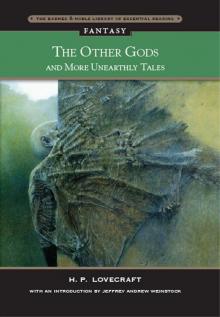 Other Gods and More Unearthly Tales
Other Gods and More Unearthly Tales Lovecraft's Fiction Volume I, 1905-1925
Lovecraft's Fiction Volume I, 1905-1925 The Shadow Out of Time
The Shadow Out of Time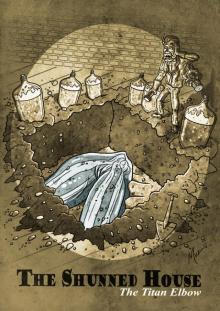 The Shunned House
The Shunned House Lovecraft's Fiction Volume II, 1926-1928
Lovecraft's Fiction Volume II, 1926-1928 The Thing on the Doorstep and Other Weird Stories
The Thing on the Doorstep and Other Weird Stories Dream Cycle of H. P. Lovecraft: Dreams of Terror and Death
Dream Cycle of H. P. Lovecraft: Dreams of Terror and Death Great Tales of Horror
Great Tales of Horror Shadows of Death
Shadows of Death Delphi Complete Works of H. P. Lovecraft (Illustrated)
Delphi Complete Works of H. P. Lovecraft (Illustrated) Waking Up Screaming: Haunting Tales of Terror
Waking Up Screaming: Haunting Tales of Terror H.P. Lovecraft Goes to the Movies
H.P. Lovecraft Goes to the Movies The Road to Madness
The Road to Madness The Complete H.P. Lovecraft Reader (68 Stories)
The Complete H.P. Lovecraft Reader (68 Stories)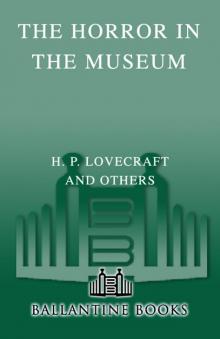 The Horror in the Museum
The Horror in the Museum Collected Fiction Volume 1 (1905-1925): A Variorum Edition
Collected Fiction Volume 1 (1905-1925): A Variorum Edition Lovecrafts_Fiction, vol.I_1905-1925
Lovecrafts_Fiction, vol.I_1905-1925 Writings in the United Amateur, 1915-1922
Writings in the United Amateur, 1915-1922 H.P. Lovecraft: The Complete Works
H.P. Lovecraft: The Complete Works Collected Fiction Volume 3 (1931-1936): A Variorum Edition
Collected Fiction Volume 3 (1931-1936): A Variorum Edition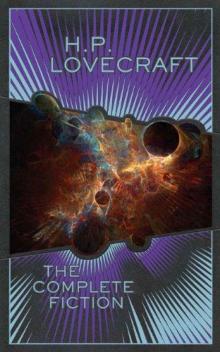 H.P. Lovecraft: The Complete Fiction
H.P. Lovecraft: The Complete Fiction Collected Fiction Volume 2 (1926-1930): A Variorum Edition
Collected Fiction Volume 2 (1926-1930): A Variorum Edition Yog Sothothery - The Definitive H.P. Lovecraft Anthology
Yog Sothothery - The Definitive H.P. Lovecraft Anthology The Complete H.P. Lovecraft Collection (Xist Classics)
The Complete H.P. Lovecraft Collection (Xist Classics)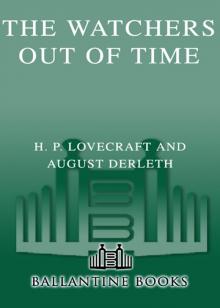 The Watchers Out of Time
The Watchers Out of Time Eldritch Tales
Eldritch Tales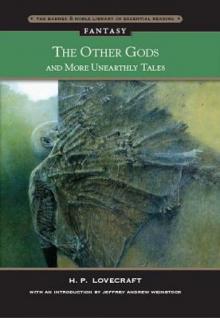 The Other Gods And More Unearthly Tales
The Other Gods And More Unearthly Tales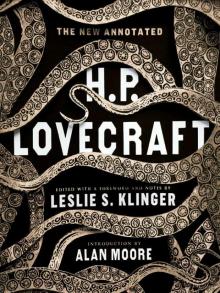 The New Annotated H. P. Lovecraft
The New Annotated H. P. Lovecraft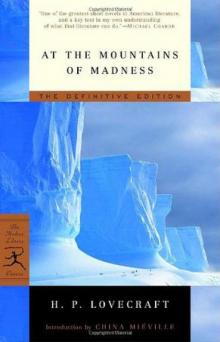 At the mountains of madness
At the mountains of madness Bloodcurdling Tales of Horror and the Macabre
Bloodcurdling Tales of Horror and the Macabre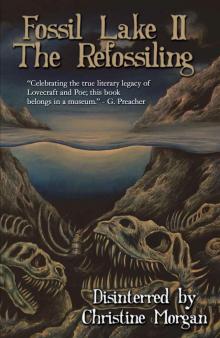 Fossil Lake II: The Refossiling
Fossil Lake II: The Refossiling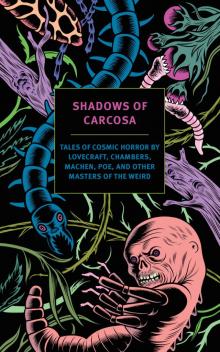 Shadows of Carcosa: Tales of Cosmic Horror by Lovecraft, Chambers, Machen, Poe, and Other Masters of the Weird
Shadows of Carcosa: Tales of Cosmic Horror by Lovecraft, Chambers, Machen, Poe, and Other Masters of the Weird H. P. Lovecraft
H. P. Lovecraft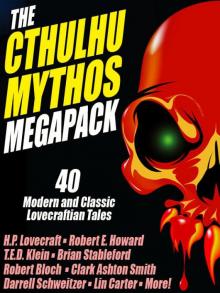 The Cthulhu Mythos Megapack
The Cthulhu Mythos Megapack The Complete H. P. Lovecraft Reader (2nd Edition)
The Complete H. P. Lovecraft Reader (2nd Edition)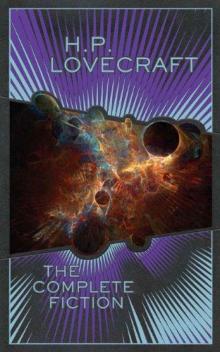 The Complete Fiction
The Complete Fiction Waking Up Screaming
Waking Up Screaming Transition of H. P. Lovecraft
Transition of H. P. Lovecraft![[1935] The Shadow Out of Time Read online](http://i1.bookreadfree.com/i2/04/12/1935_the_shadow_out_of_time_preview.jpg) [1935] The Shadow Out of Time
[1935] The Shadow Out of Time The Horror Megapack
The Horror Megapack